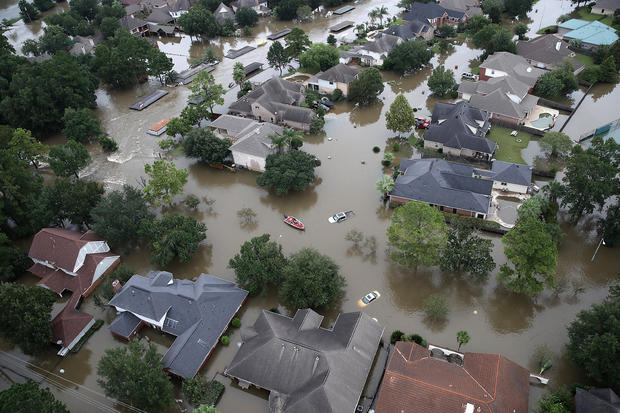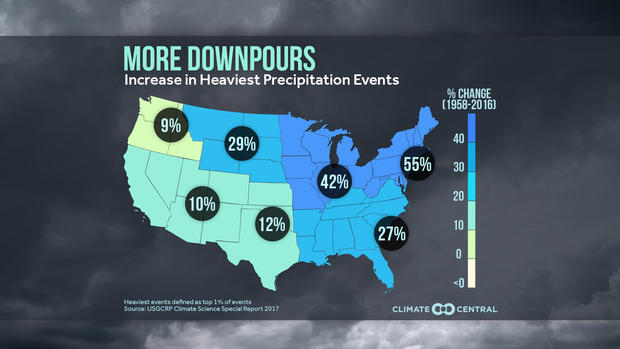Climate change is responsible for billions of dollars in flood costs, study says
Over the past 40 years, damage from major weather and climate disasters has cost the United States nearly $2 trillion dollars. A closer look at the data reveals that recently the cost of such incidents has been escalating quickly, due in part to human-caused climate change.
According to NOAA's assessment of the biggest U.S. weather disasters — those with an inflation-adjusted cost of a billion dollars or more — the economic toll rose from an average of $17.8 billion a year in the 1980s to over $81 billion a year in the 2010s.
Now a new study from Stanford University puts a number value on the portion of the increasing costs caused specifically by the rise in floods linked to climate change. The study, published in the Proceedings of the National Academy of Sciences, examines flooding related to rain and snow events and finds that of the $199 billion in U.S. flood damage from 1988 to 2017, more than one-third is directly related to trends in intensifying precipitation.
Two recent disasters that come to mind in which flooding made up the vast majority of economic damage include 2017's Hurricane Harvey, which cost the U.S. a staggering $125 billion, and the historic 2019 Midwest floods which devastated the heartland and cost around $3 billion.
But how much of the financial toll of disasters like these is due to climate change making things worse, and how much is due to socioeconomic factors like increased population and value of assets? This study helps to clarify this debate among many experts who work in disaster-related fields. That's important because, with the impacts of climate change continuing to mount, there's an urgency among scientists and economists to quantify how much climate change is costing us and how much it may cost us in the future.
Dr. Noah Diffenbaugh, co-author of the research and professor of Earth System Science at Stanford University, says obtaining this quantification was the motivation for this study. "There has been a lot of research about the impacts of climate change on different natural and human systems, but relatively little of that has focused on generating hard numbers quantifying the financial costs of those impacts," Diffenbaugh said. "This study provides those numbers for flooding, which is one of the most costly natural disasters."
The mechanism behind why climate change is causing more extreme floods is very straightforward: a warmer ocean and atmosphere provides more energy to fuel more extreme weather systems.
To start with, a warmer atmosphere can hold more moisture and dump more precipitation. A simple equation called the Clausius-Clapeyron rate calculates that for every 2 degree Fahrenheit increase in air temperature, the atmosphere can hold 8% more moisture, and thus produce more rain or snow.
However, the extra energy in the Earth system goes a step further. A warmer atmosphere and ocean can also power more intense weather systems, which increase rainfall rates and also the overall precipitation which falls in a storm. So, even if a region's average rainfall is decreasing, individual storms still tend to produce more precipitation.
"The most extreme events have been intensifying more rapidly as a result of climate change, and this is a pattern that is true across the country, even in regions where average precipitation has not changed or has decreased slightly," explains the study's lead author, Frances Davenport, a PhD student at Stanford Earth.
When asked how much of the increased extreme rain was due to climate change versus natural pattern changes, Davenport said, "While natural climate variability has also had some effect on precipitation over the historical time period, the observed changes in extreme precipitation are very consistent with what we expect to occur as a result of human-caused climate change."
Davenport says that the flood damage cost from rainfall in Hurricane Harvey, which dumped up to 60 inches of rain on Texas's Gulf Coast, made up about 20%of the $199 billion evaluated in her study. A series of studies after Harvey found that climate change resulted in the storm dumping up to 38% more rainfall than it otherwise would have.
These more extreme precipitation events more easily overwhelm infrastructure like flood barriers and drainage, which were built for the tamer climate of the 1900s, not the souped-up climate of the 2000s. The image below shows this is also true for rivers and streams, many of which have seen an increase in streamflow since the 1980s.
In order to calculate which portion of the flood damage between 1988 and 2017 was due to increases in extreme events on a warmer planet, the team started with higher resolution climate and socioeconomic data and then applied advanced methods from economics and statistics. Using these tools they constructed an economic model to analyze the relationship between observed precipitation and flood damage month by month and state by state.
They also used the model for a counterfactual analysis in which they calculated what the damages would be if there were no changes in extreme precipitation.
Together, these analyses revealed that climate change has contributed substantially to the growing cost of flooding in the U.S. Overall, the study found 36% of the cost of flooding over that time period can be attributed directly to increasing extreme precipitation events, or almost $75 billion of the estimated $199 billion total.
And with much more climate heating anticipated in the future, the team says the proportion of costs due to extreme events will only get worse.
"Our analyses show that exceeding the 2 degrees Celsius level of global warming identified in the U.N. Paris Agreement is likely to result in further intensification of extreme precipitation," says Diffenbaugh. "So, if the future is anything like the past, we can expect continued increases in flood damages from future changes in precipitation."
Beyond the impact from flood events, Diffenbaugh says the study goes further by establishing a methodology for economists to apply on various forms of extreme weather going forward. "The study provides a framework for calculating how much climate change is likely to cost in the future, as well as the economic value of reducing emissions in order to limit the level of global warming," he said.
"Much of the concern about taking action to limit global warming has been framed around how much it will cost to transition from fossil fuels," Diffenbaugh added. Indeed, "It will cost too much" is a familiar refrain among those who oppose action to combat climate change, to which the climate-concerned always counter: "We can't afford not to." That's because as the planet gets warmer, the impacts of climate change increase exponentially.
The team's findings provide a method to separate the costs of the different variables — vital pieces of the puzzle for policy makers who must weigh the costs of action versus inaction. Armed with this understanding, they can use cost-benefit calculations to determine how, and how much, to invest in climate mitigation and adaptation.
The need for these calculations is becoming more and more important, because as the climate warms, Diffenbaugh says, the costs of inaction continue to increase.
"This study shows that changes in precipitation are already costing billions of dollars, and that we can expect more global warming to further intensify the precipitation events that are driving those climate-related costs."






